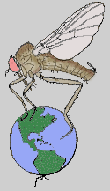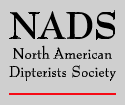
| Home | Family Key | Identification Table | |||
![]()
Diptera Associated with Livestock Dung
House fly Musca domestica L.
 |
Musca domestica is nearly cosmopolitan in distribution.
House fly adults typically occur in and around barns, stables, feedlots and confined animal facilities. Adults average about 5 - 8 mm long. They are gray in colour with 4 dark stripes on the thorax, with a primarily gray black patterned abdomen; in both sexes the abdomen is yellowish on the sides [fig.]. Mouthparts form a fleshy proboscis, which is not visibly extended forwards from the head as a long slender piercing structure. In the male the eyes are well separated above [fig.].
Eggs are without a terminal respiratory horn as seen in the face fly [fig.].
Larvae (3rd instar) are yellowish white maggots about 11 mm long. They are cylindrical and taper anteriorly. Two moderately separated "D"-shaped spiracles are located on the rear end. Each spiracle is outlined by a thin, dark band, with 3 sinuous-shaped slits surrounding a button located towards the inner edge[fig.].
Puparia are reddish brown and 4 - 7 mm long. The respiratory horns found along the posterior border of the 4th segment are small but visible, and are darkened basally. The posterior spiracles are black with 3 sinuous-shaped yellow slits; the spiracles are "D"-shaped and moderately separated from each other [fig.].
House flies are common on animals in confined rearing facilities and other buildings. Adults do not bite but annoy animals by congregating around orifices, wounds, and soiled regions. Females lay eggs in moist decaying organic matter, such as manure, garbage, silage, and food wastes. Larvae complete development and pass through 3 instars usually within one week to 10 days. They spend a further week to 10 days as puparia before emerging as adults. At 25 degrees Celsius, the entire life cycle from egg to adult is completed in 14 to 18 days. Several generations occur during the course of the summer and breeding may continue throughout the year in warm buildings. In unprotected breeding sites house flies overwinter as larvae or puparia.
Damage, Economic Impact & Management:
Large numbers of house flies in confined facilities annoy livestock, decreasing weight gain and milk yields. House flies transmit several diseases and pathogens that are harmful to livestock.
Current management practices primarily involve waste sanitation, pesticide application and biological control methods.
More detailed information on the economic impact and management of house flies can be found at the following sites:
Filth fly web pages developed by
J.M. Cumming and B.E. Cooper
First published on the Internet in 1998
Last updated 18 May 2006 by J.M. Cumming and G.D. Murray
![]()
